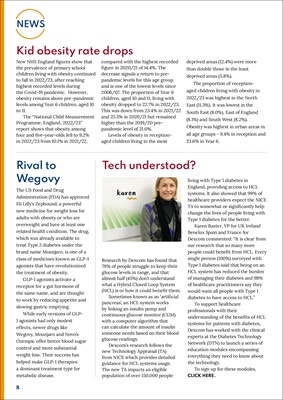
8
NEWS
Kid obesity rate drops
New NHS England figures show that
the prevalence of primary school
children living with obesity continued
to fall in 2022/23, after reaching
highest recorded levels during
the Covid-19 pandemic. However,
obesity remains above pre-pandemic
levels among Year 6 children, aged 10
to 11.
The "National Child Measurement
Programme, England, 2022/23"
report shows that obesity among
four and five-year-olds fell to 9.2%
in 2022/23 from 10.1% in 2021/22,
compared with the highest recorded
figure in 2020/21 of 14.4%. The
decrease signals a return to prepandemic levels
for this age group
and is one of the lowest levels since
2006/07. The proportion of Year 6
children, aged 10 and 11, living with
obesity dropped to 22.7% in 2022/23.
This was down from 23.4% in 2021/22
and 25.5% in 2020/21 but remained
higher than the 2019/20 prepandemic level
of 21.0%.
Levels of obesity in receptionaged
children living in the most
deprived areas (12.4%) were more
than double those in the least
deprived areas (5.8%).
The proportion of receptionaged
children living with obesity in
2022/23 was highest in the North
East (11.3%). It was lowest in the
South East (8.0%), East of England
(8.1%) and South West (8.2%).
Obesity was highest in urban areas in
all age groups - 9.4% in reception and
23.6% in Year 6.
Tech understood?
Research by Dexcom has found that
79% of people struggle to keep their
glucose levels in range, and that
almost half (45%) don't understand
what a Hybrid Closed Loop System
(HCL) is or how it could benefit them.
Sometimes known as an 'artificial
pancreas', an HCL system works
by linking an insulin pump and
continuous glucose monitor (CGM)
with a computer algorithm that
can calculate the amount of insulin
someone needs based on their blood
glucose readings.
Dexcom's research follows the
new Technology Appraisal (TA)
from NICE which provides detailed
guidance for HCL systems usage.
The new TA impacts an eligible
population of over 150,000 people
living with Type 1 diabetes in
England, providing access to HCL
systems. It also showed that 99% of
healthcare providers expect the NICE
TA to somewhat or significantly help
change the lives of people living with
Type 1 diabetes for the better.
Karen Baxter, VP for UK Ireland
Benelux Spain and France for
Dexcom commented: "It is clear from
our research that so many more
people could benefit from HCL. Every
single person (100%) surveyed with
Type 1 diabetes said that being on an
HCL system has reduced the burden
of managing their diabetes and 98%
of healthcare practitioners say they
would want all people with Type 1
diabetes to have access to HCL."
To support healthcare
professionals with their
understanding of the benefits of HCL
systems for patients with diabetes,
Dexcom has worked with the clinical
experts at the Diabetes Technology
Network (DTN) to launch a series of
education modules encompassing
everything they need to know about
the technology.
To sign up for these modules,
CLICK HERE.
Rival to
Wegovy
The US Food and Drug
Administration (FDA) has approved
Eli Lilly's Zepbound, a powerful
new medicine for weight loss for
adults with obesity or who are
overweight and have at least one
related health condition. The drug,
which was already available to
treat Type 2 diabetes under the
brand name Mounjaro, is one of a
class of medicines known as GLP-1
agonists that have revolutionized
the treatment of obesity.
GLP-1 agonists activate a
receptor for a gut hormone of
the same name, and are thought
to work by reducing appetite and
slowing gastric emptying.
While early versions of GLP1 agonists
had only modest
effects, newer drugs like
Wegovy, Mounjaro and Novo's
Ozempic offer better blood sugar
control and more substantial
weight loss. Their success has
helped make GLP-1 therapies
a dominant treatment type for
metabolic disease.